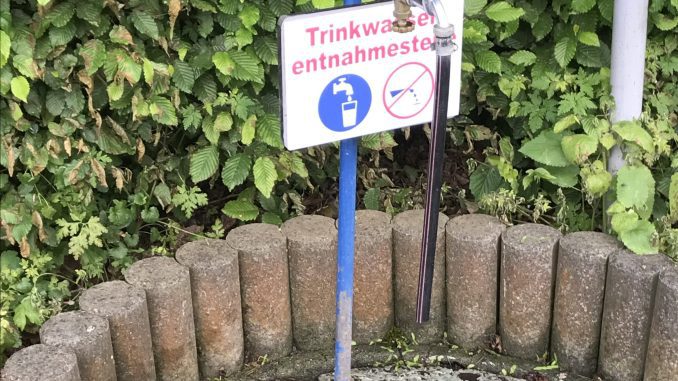
As summer begins, so does the camping season. The campers use the site’s infrastructure and depend on the care of the site operator, especially when it comes to water. Therefore I wanted to know, what campsite operators must actually do and consider, so that with the water everything has its order. I am a camper myself. The water facilities on the campsites do not always make the best impression. If you then have doubts about the quality of the drinking water and the condition of the sanitary facilities, you should inquire and ask the operator about it. What he should know for this, explained to me on inquiry equally promptly as comprehensively the Federal Environment Agency.
The water supply systems at campsites are subject to official controls
The water pipes and the tapping points as well as the showers and washbasins in the washhouses on campsites are legally designated as “water supply installations”, where the legal requirements of the “Drinking Water Ordinance” have to be fulfilled (paragraph 3 Nr. 2(f). It must be possible to draw water of drinking quality from the pipes. Not everywhere it is pointed out so clearly, as on the contribution photo (although the hose is unsuitable).
The campsite operator is responsible for the proper operation of these water supply systems. The latter must report the installations to the local health department. This is responsible for the official control, as with other publicly accessible drinking water tapping points. The public health department monitors compliance with the legal regulations and determines the intervals at which drinking water tests are to be carried out and the scope of the respective sampling. Since campgrounds are commercial facilities, drinking water installations must be monitored at least once a year. Following the so-called “risk-based approach”, the health authority must ensure that at least those parameters are examined which can be assumed to change adversely in the drinking water installation, i.e. for example because the drinking water has been in the pipe for a longer period of time.
As a rule, the health authorities require when notifying the (re-) start-up of the drinking water installation on a campsite. So for example after the winter break then the test report of an approved analysis institute must be submitted, in which the health of the drinking water and thus the perfect condition of the installation are certified.
If you want to know, you should ask the campsite operator about the water quality. The latter is legally obliged to make all relevant information known “without delay to all consumers concerned in writing or by means of a notice board.” So if the campsite does not make the information known by posting, which in my experience is very rare, I would ask.
If you want to be on the safe side, you should let the water run for a while until it comes out cold – but most campers already know that.
Campers must also pay attention to quality
The campsite operator is usually only responsible up to the transfer point, i.e. up to the tap – be it at the pitches or in the wash houses. The campers themselves are responsible for the hoses and tanks that they connect to them. In the case of hose lines, the layman sees that e.g. on DVGW test marks or indications such as “KTW tested” or “W 270 tested”. Most garden hoses do not meet the requirements for use with potable water. Water that stands in it for a long time should at best only be drunk boiled. What campers have to observe in their caravans and mobile homes would go beyond the scope of this article.
Legionella on German camping sites probably no topic
In shower facilities, legionella could also be an issue if not operated properly. Here the Federal Environmental Agency gives the all-clear. There are no reports of outbreaks of legionellosis at campsites in Germany. The drinking water installations supplying the individual campsites are usually cold water pipes laid in the ground. Legionella are more problematic in hot water pipes or in pipes in which the cold water is heated to over 25°C. At campsites, therefore, problems with legionella are more likely to occur in hot water pipes, for example in shower rooms. If the shower rooms are used seasonally, the requirements for water supply systems apply. In the case of permanently used shower rooms, there is an annual obligation to test for legionella if the system is large (more than 400 liters of hot water in the storage tank or more than 3 liters of hot water in the pipes). If the permissible limit values are exceeded, the responsible public health department is informed directly by the examining laboratory.
ADAC gives the all-clear on water quality
Some time ago I had already asked the ADAC, which evaluates the places with its ADAC camping guide, for its experiences. In the sanitary area, this only checks according to the criteria “state of preservation”, “constructive characteristics” (structural design) and (optical) cleanliness. Verification of compliance with relevant legal standards, such as. B. of the drinking water regulation, it cannot afford and refers justifiably to the competence of the authorities.
The following resume from the ADAC probably refers more to campsites in southern Europe: “Overall, the number of complaints about drinking water at campsites is rather low, either because campers do not have very high expectations of water quality in certain vacation regions or because the tap water is not recommended as a beverage due to the regionally high chlorine dosage.”
Contribution photo: Gendries (by the way, the hose on the photo does not correspond to the regulations and actually does not belong there. The operator of the beautiful campground in Diez an der Lahn, asked about it, assured me that they would be replaced shortly.